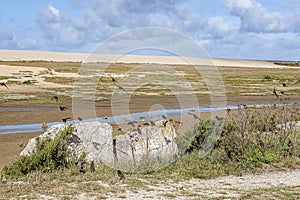- Price: 1$
- Size Facebook: 1702 x 630 px
- Size Twitter: 1500 x 500 px
- Size LinkedIn: 1128 x 191 px
More Facebook, Twitter and LinkedIn Cover Photos
Cover photo info
- Photo title: A flock of birds perched or flying around large rocks visible at low tide on the Fleet lagoon, near Portland Dorset
- Author: Doranta
- Cover photo description:
- An early morning walk on a beautiful summer day and a flock of birds sighted perched on rocks visible at low tide on the Fleet lagoon near Portland, Dorset. The Fleet lagoon was formed when Chesil Beach moved onshore as the sea levels rose. In the past it was much larger than it is today. The Fleet is 13.1 km 8.2 miles long and covers an area of 480 hectares. The width varies from 900 metres at Littlesea down to just 65 metres at The Narrows. The deepest part is in the lower Fleet where it is 4-5 metres deep. Most of the upper Fleet above The Narrows is no more than 2 metres deep. The Fleet connects to the sea via a narrow channel at Ferrybridge into Portland Harbour. Sea water can also enter the Fleet by percolation through Chesil Beach under some tidal conditions. Fresh water can enter the Fleet from a number of small streams and by run-off from the surrounding fields. The bouncing bomb, designed by Barnes Wallis and immortalised in the film The Dam Busters, was tested on the waters of the Fleet. In September 1942 the first full-scale test drops of the bomb were carried out using a modified Vickers Wellington bomber.
- Image ID:185380133
- Views:0
- Downloads:0
Keywords for Facebook, Twitter and LinkedIn timeline photos
beach
birds
blue
channel
chesil
cliffs
clouds
cloudy
coast
coastline
day
daylight
destination
dorset
dramatic
ebbed
england
europe
family
flint
flock
flying
holiday
holidays
jurassic
lagoon
landscape
morning
nature
nobody
ocean
outdoor
outdoors
pebbles
portland
rocks
rural
scenery
sea
seascape
season
shore
sky
starlings
summer
tide
travel
warm
water
weymouth














